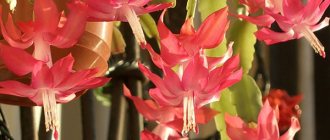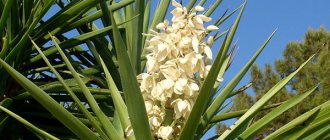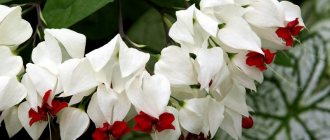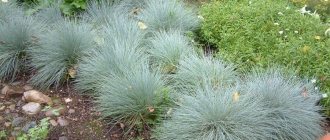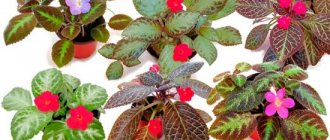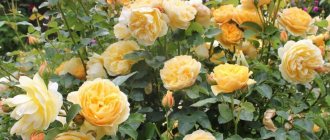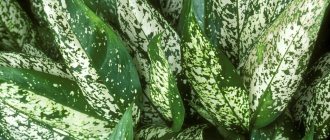Aglaonema is another species of tropical representatives that are very popular with professional flower growers and indoor plant lovers. It came into home collections relatively recently, about 60 years ago. In this article I would like to introduce you to this unusual plant, the diversity of its species, the intricacies of care and propagation.
A little about the plant
Aglaonema belongs to the Araceae family. In nature, this plant is found in the tropical forests of India, China, New Guinea and Asia. It can also be found on the banks of streams or rivers, in swampy areas and on wet plains. It is grown as a beautiful decorative foliage plant.
- It grows in the form of a beautiful, evergreen bush. It can grow a little more than 1 m in height. It begins to branch from the base; over the years, a small trunk is formed, on which traces of dried leaves are visible.
- The leaves are dense, leathery, oblong with different colors, which depend on the type of plant.
- The inflorescence is a spadix with a light, yellow-green veil, which in its shape resembles a spadix, like that of Spaciphyllum. Depending on the species, the cobs can be thin or thick. The fruits take a long time to ripen, more than six months.
It is believed that aglaonema moisturizes and purifies indoor air from streptococcal and other pathogenic bacteria.
| IMPORTANT Remember that aglaonema juice and berries are poisonous to humans! Wear gloves when working with the plant. Keep children away from the plant. |
Aglaonema variable: interesting facts
Aglaonema variablea is a very effective, and at the same time quite attractive, natural filter for indoor air. The silvery leaves of this beauty, like a vacuum cleaner, pull out from the air all harmful substances and heavy metals that enter the house along with all kinds of paints, varnishes, impregnations, as well as furniture and other household items. In addition, they attract mold pollen, which also negatively affects the human body. That is why Aglaonema changeable is the best plant for people with bronchial asthma and allergy sufferers.
Types and varieties of Aglaonem
There are about 50 species of Aglaonema and more than 200 hybrid varieties. The most common and beautiful varieties of Aglaonema are described below.
Aglaonema modesta (moderate)
In nature, it grows in China and the surrounding area. Has several subspecies. The leaf blade can be painted a solid green color or be variegated. It grows up to 50 cm in height. The leaves are wide, pointed, glossy and slightly wavy at the edges. The fruits are bright red. It is considered the most unpretentious species.
It grows well even in the dark corners of our houses, but it is better if it is a bright room - constant stress from lack of light will affect the general condition of the plant and the beauty of the leaves.
Photo: Aglaonema modestum
Aglaonema variablea (variable)
Found naturally in the Philippines. The leaves are elongated, greenish with green or silver veins, depending on the species, located on dense and tall stalks. The length of the leaf can be up to 30 cm and the width up to 10 cm. The edge of the leaf is slightly wavy. It can grow up to 1 m in height. Up to 5 flower stalks can form on one plant, reaching a height of 20 cm.
Photo: Aglaonema commutatum
Silver Queen
The most common hybrid variety of Aglaonema changeable (Silver Queen).
The leaf plate is colored silver-green with green veins located throughout the leaf. In the southern regions, where there are no sub-zero temperatures in winter, this variety is grown outdoors as a garden flower.
The variety is very unpretentious and is suitable for cultivation by beginning flower growers, as well as those who want to get acquainted with this plant for the first time and get a positive result and experience. Blooms every year, under the right conditions.
Photo: Silver Queen variety
Silver King
Also quite common is the hybrid variety of Aglaonema changeable Silver King. Not only its leaf blades are painted silver, but the entire base of the petioles. It turns out to be a very delicate bush.
Photo: Silver King variety
Aglaonema Round
Low-growing appearance. The leaves are heart-shaped. Painted dark green with thin veins. The color of the veins depends on the variety. They can be white, pale pink, crimson. Thanks to these veins, the plant looks very gentle and creates a romantic atmosphere.
Photo: rounded aglaonema (Aglaonema rotundum)
Short-vegetated Aglaonema
The main difference between this type of Aglaonema and others is that it does not have stems. It is in the ground, and green, elongated and pointed leaves immediately begin to grow from the ground. Along the central vein of the platinum sheet there is a white, thin, contrasting stripe.
Thanks to these properties, the plant grows as a very lush and compact bush. This plant will look ideal in interiors where there are white stripes or spots, as well as in the nursery, bedroom and kitchen.
Photo: Aglaonema Brevispathum
Painted Aglaonema
It forms very lush bushes, up to 60 cm high. The bush branches quite strongly in the lower part, forming many new shoots. The leaves are elongated, with pointed ends, and can grow up to 20 cm in length. The ripe fruits are red, inedible, like all fruits of other Aglaonema species.
The color is spotted, reminiscent of a khaki print. Shapeless spots can be whitish-cream and greenish-gray and blue, distributed in a chaotic manner over the entire surface.
If you squint at this plant, the background color will appear bluish-silver. There are both two-color and three-color colors, depending on the variety.
Photo: Aglaonema pictum
Aglaonema splendor
It grows up to 1 meter in height. The leaves are large, dense and shiny, colored green. The shape of the leaf blade is oval, it can reach up to 40 cm in length and up to 20 cm in width. The length of the cob flower is about 6 cm. The trunk is dense and stable, and becomes bare from below over time.
Photo: shiny aglaonema (Aglaonema nitidum)
Aglaonema Crete
It can reach a height of 70 cm. The leaves are oblong, with a pointed tip and very bright, variegated colors. The leaf grows up to 15 cm in length. If you touch the central vein with your hands, you can feel that it is pressed into the leaf and protrudes from the back side.
It is valued by flower growers for its attractive colors. When examining the leaves, you can count several green and red shades.
Photo: Aglaonema Crete
Cutless
Hybrid variety "Cutlass". The leaves are elongated and narrow. A very impressive and compact plant, suitable for any interior: from an office to a country house. Leaf platinum is painted in a silvery-greenish color with dark green splashes along the perimeter of the sheet. Loves good lighting and a warm atmosphere.
Photo: aglaonema Katlees, or Kutlass
Friedman
Painted Aglaonema, variety Freedman. It can grow up to 1 m in height. The leaves are quite wide with a ribbed surface, on a high and dense stem. The platinum sheet is painted in a soft green hue with small green splashes throughout the surface.
Grows very well in home greenhouses and large pots. Easy to care for, it is best to grow in a bright room, without access to direct sunlight. It can also grow in a dark corner.
Photo: Aglaonema Friedman
Reproduction
Spring is the ideal time for the propagation of aglaonema. Reproduction is carried out mainly using stem cuttings or shoots, sometimes by seeds.
It is better to cut species with vertical stems in this way:
- At ground level, it is necessary to cut off most of the plant and plant it in a pot with loose soil. The composition of the soil is exactly the same as when growing adult plants.
- The formation of roots begins from “dormant” buds in the stem.
- New shoots will appear from the aboveground part of the plant.
- Until the plant is completely rooted, it should not be over-watered.
Stem cuttings
Cuttings must be carried out not only to propagate the plant, but also when the aglaonema grows strongly and its presence in the pot becomes unstable.
- The most overgrown stem is selected and cut off at a level of 2-3 cm above the soil.
- Divide the shoot into several 5 cm pieces.
- Each shoot should be cleared of leaves.
- To root, you need to take a box, fill it with drainage, and fill it with a mixture of sand and peat.
- After the cuttings have given roots, they should be planted in separate pots. The soil should be used as for replanting.
Cuttings with lateral shoots
You can take cuttings not only from the stems of aglaonema, but also from the lateral shoots.
- First you need to water the soil generously, then carefully remove the aglaonema from the pot.
- Clear the roots from the soil and separate the daughter shoots from the main part of the plant.
- Plant in separate pots, watering regularly and controlling air humidity.
- The soil will be exactly the same as when transplanting.
- Rooting ends with the appearance of new leaves.
Seeds
Aglaonema is a self-pollinating plant that bears fruit abundantly. Ripe seeds are found in brightly colored fruits.
- Harvest the fruits when they are fully ripe. It is better to use only fresh seeds for planting.
- Remove the seeds from the fruit and rinse to remove the pulp.
- Deepen into moist sphagnum 1-1.5 cm.
- Set up a greenhouse by covering the container with film or glass. The humidity in the greenhouse should be high, and the temperature should be between 20-26 degrees.
- Shoots will appear in 20-25 days. Sometimes shoots appear later.
- After the rosette grows to 5-7 cm in diameter, it should be picked and transplanted into a pot with a substrate consisting of a mixture of universal soil, peat and perlite in equal proportions. You can add charcoal or steamed bark to the soil.
The subtleties of growing aglaonema at home
At home, different types and varieties of aglaonema feel great, often bloom and bear fruit.
Temperature
Loves moderate temperatures, in summer from +20 to +26 °C, and in winter from +16 to +20 °C. Try to avoid sudden temperature changes. In the summer, it is best to take the plant outside, to a shady place or to a greenhouse. But before that, harden off the plant and make sure there will be no more frosts.
She doesn't like drafts either. Cold air entering the plant in winter is especially dangerous. The cold may cause the roots to freeze and then begin to rot.
Light
They like partial shade or bright, diffused light, depending on the species. In nature, Aglaonemas grow in the lower layer of the tropical forest, where little light reaches. Therefore, they all tolerate shading and partial shade well. But variegated species are better placed in a well-lit place, without direct sunlight on the leaves of the plant. This way the color will be as attractive as possible, and the sun will not cause burns on the leaves.
- Variegated species love bright lighting, without direct sunlight,
- Species with a single color are best placed in the shade.
Watering and humidity
You need to water with “soft” water - rain, snow or settled water. But do not overdo it with watering, since overwatering is just as destructive for Aglaonema as completely drying out the earthen clod.
- In the summer, you need to water frequently and abundantly so that the substrate is always moist.
- In winter, we reduce watering, but make sure that the soil does not dry out.
Loves strong air humidity. Dry air has a bad effect on the development of the plant; when the leaves unfold, they do not have sufficient moisture and, as they unwind, they become deformed and lose their attractive appearance. Also, the edges of the leaves may dry out.
- Frequent spraying and bathing in the shower have a beneficial effect. In winter, it is advisable to spray and bathe with warm water.
- You can also place a bowl of water next to the plant, which will provide additional evaporation of moisture, especially if the plant is on a windowsill or near a radiator.
- Or place the pot itself on a tray with damp expanded clay, moss or pebbles, while making sure that the pot is not in water.
Top dressing
Responds well to fertilizing with universal flower fertilizers. Fertilizers need to be applied every 2 weeks from March to August. The rest of the time, the plant begins a period of rest, it slows down in growth and does not need feeding.
Planting and transplanting
Young plants need to be replanted every spring into a slightly larger pot with a new nutrient substrate. This way they grow and develop much more actively. Mature plants can be replanted or transplanted every 2 to 4 years, depending on need.
The substrate for Aglaonema is easy to make yourself; it must be nutritious and air and moisture permeable:
- You need to take 3 parts of leaf or garden soil, 1 part of peat, 1 part of washed river sand and 0.5 part of crushed charcoal. Mix all this thoroughly.
- Be sure to place drainage at the bottom of the pot, at least 5 cm. Expanded clay, fine gravel, pebbles, and polystyrene foam broken into small pieces can be used as drainage.
Aglaonema grows very quickly in hydroponics.
Aglaonema changeable: history and features of the name
Aglaonema variablea was brought to Europe at the end of the 17th century, during the time of the Great Geographical Discoveries.
However, it did not arouse much interest among European gardeners at that time, so it was grown for quite a long time exclusively as a greenhouse plant. The main reason for this is the rather capricious nature of this flower, which requires a reverent and attentive attitude. The situation changed radically only at the end of the 20th century, with the release of the wonderful French film “Leon”, with Jean Reno in the title role. It was Aglaonema who played in this film the role of the protagonist’s best friend, who could trust her with all his worries and dreams. This plant looked so impressive on the screen that literally the next day after the film was released, it became one of the most popular indoor perennials in the whole world.
The first scientific description of Aglaonema variablea was made by the famous botanist Heinrich Wilhelm Schott in 1835. It was he who gave this plant its generic name “aglaonema”, which translated from ancient Greek means “bright thread”. It received such an unusual name due to the bright color of its pistils.
Care problems
- Deformed leaves and dry edges: little humidity in the air or insufficient watering of the plant.
- The leaves are curled and dry at the edges: exposure to cold air or frequent drafts.
- There are whitish spots on the leaves: sunburn. Urgently move the plant to another place where there is no direct sunlight. Let it stand there for a while and “go away”, and then spray with warm water and water.
- Slow plant growth: Watering with “hard”, unsettled or cold water. To reduce the hardness of water, you can add a little citric acid to it, literally at the tip of a knife.
Pests of Aglaonema:
- spider mite,
- aphid,
- thrips,
- whitefly
If you find any of the representatives, immediately treat the plant with folk remedies or ready-made preparations from the store. Of course, using traditional methods will be more environmentally friendly and healthier for you and the plant. At first I use only them, and if it doesn’t help, only then use chemistry.
But, as a rule, traditional methods always work 100%, the only thing is that you have to process the plant several times, but we do not harm nature.
How to propagate
There are several ways to propagate Aglaonema:
- seeds,
- you can cut off the apical shoot and root the cutting,
- break off the grown offspring (shoot),
- or divide the rhizome when transplanting.
It is best to propagate in the spring, but it can also be propagated in the summer until July.
Reproduction by apical shoot (cuttings)
In the spring we choose an escape. With age, Aglaonema becomes elongated, the lower part of the trunk becomes bare and looks unsightly - it requires rejuvenation. Also, the trunk itself can collapse and eventually break completely. These are the shoots that should be chosen first for cuttings.
- It can be torn off with clean hands, but it is best to cut it off with a sharp, disinfected knife, pruning shears, or scissors.
- It is best to cut off the shoot closer to the surface of the earth, leaving a stump on the mother plant 2–3 cm long.
- If the shoot is long, then it can be divided into several cuttings. Each cutting can be made 10 - 18 cm.
- Using your hands, carefully tear off the lower leaves at the base of each cutting. You can cut them off with the sharp tips of garden shears.
- It is advisable to dip the lower tip of the cutting a little in a preparation for root formation (kornevin).
Rooting in water
Then the cutting can be placed in water. Water should cover the lower part no more than 5 cm.
Cuttings with roots can be planted several pieces in 1 pot. This way the plant will look more attractive and you will quickly get a ready-made lush Aglaonema bush.
Rooting in soil
Or you can immediately plant it in prepared, pre-watered soil. We immerse the cutting in the ground to half its length. Water again and lightly press the soil on top with your fingers; if necessary, add a little soil to the pot.
- We put a plastic bag on top of the plant or cover it with a plastic container to get a greenhouse effect. This will allow the plant to take root faster.
- We ventilate the plant periodically, for 15-20 minutes a day, so that drops of condensation do not over-moisten the substrate and accumulate on the leaves.
- Place in a warm place, out of direct sunlight.
Make sure that the soil during rooting is not too wet and does not cause putrefactive processes. It is necessary to water moderately, only as the top layer dries.
When you notice that the plant has begun to grow, and this happens usually after 2 weeks in spring and summer and about a month in winter. New leaves will begin to appear, and the plant itself will look stronger; we clean the greenhouse and care for it as usual.
Propagation by seeds
This is also a very effective method of propagation, given that Aglaonema readily blooms and bears fruit at home and does not require artificial pollination.
You need to wait until the red berry is completely ripe on the bush. Determining the ripeness of the fruit is quite easy - when touched, the berry should fall into your hand on its own.
Our seeds always have 100% germination, tested repeatedly. Seed germination is especially good in the first year.
Sowing
- We separate the seeds from the pulp and plant them in a loose, nutritious substrate to a depth of 1–2 cm.
- We do not compact the earth on top, but leave it as loose as possible.
- We water by spraying so that the seeds do not get buried and germinate evenly.
- Cover the top with glass or plastic wrap. Place in a warm, bright place.
- When we see that the first shoots have sprouted, we immediately remove the covering material.
We water by spraying from a spray bottle until the seedlings become stronger and require planting into separate pots.
Diseases and pests
Aglaonema is resistant to infections. However, improper care at home can cause the flower to become infected.
The plant is characterized by the following problems:
- Spider mite. The pest settles under the leaves, forming a thin web. The tick is dangerous because it drinks the sap of the plant. You can get rid of mites by treating the flower with insecticides, in other words, chemicals, or by pouring hot water over it for two minutes.
- The appearance of gray rot . The disease appears on the leaves of aglaonema in the form of gray spots that are soft to the touch. A solution of copper sulfate will help remove rot, as well as removing the affected parts of the flower.
- Root rot . The cause may be excessive watering, low temperature and cold water. The problem can be solved by the following steps: increase the temperature, reduce watering, remove affected roots, water the plant only with warm water.
- Aphid attack . If you notice that the leaves have begun to curl, then most likely the aglaonema is being attacked by aphids. Usually this pest does not hide, but forms its colonies on the underside of the leaf. To get rid of aphids you need to acquire the following drugs: Lannat or Aktara. You can use folk remedies, for example, spraying the plant with an infusion of garlic or onion.
- Rust formation . This is a kind of fungus that affects the leaves of aglaonema with orange growths that are soft to the touch. The upper part of the leaf is covered with golden spots. In this case, the diseased leaves are cut off, and the bush is completely treated with young sulfur.
- When caring for aglaonema at home, you can see sooty fungus or black fungus on the leaves of the flower . When a disease attacks a plant, it affects the leaves, forming a film on them. Afterwards, fungal spores appear in the form of droplets on the leaves. This plaque clogs the pores of the plant, preventing photosynthesis and respiration of the flower. To solve the problem, use insecticides, rinse the plant with warm water, and wipe the leaves with a cotton swab.
- Feltworts or pseudocushions . Pests attack the leaves, deforming them, causing them to dry out and crumble. Finding an unexpected guest is not difficult; he settles on the stems and leaves of aglaonema. In appearance it looks like a lump of cotton wool. Such drugs as Fazol or Fitoverm are effective in killing parasites.
- Whitefly . This insect looks like a moth. Its length is 2-4 mm. The larvae settle on the underside of the leaf and feed on the sap of the flower. For treatment, use the insecticide Actellik (one ampoule per liter of water).
- Thrips . Small insects that feed on plant sap. First, stripes and spots of white and silver appear on the leaves. Afterwards, the tissue in the pest’s habitat dies. To solve the problem, insecticides are used: Fitoverm, Karate, Actellik, Karbofos. You can also rinse the plant under a warm shower.
